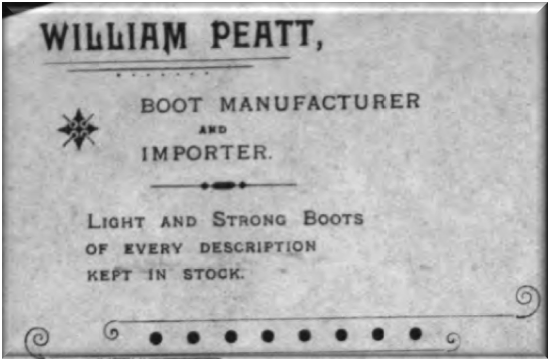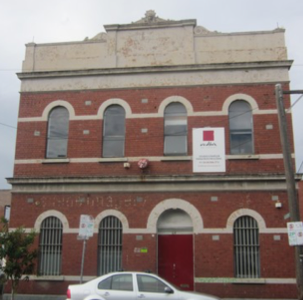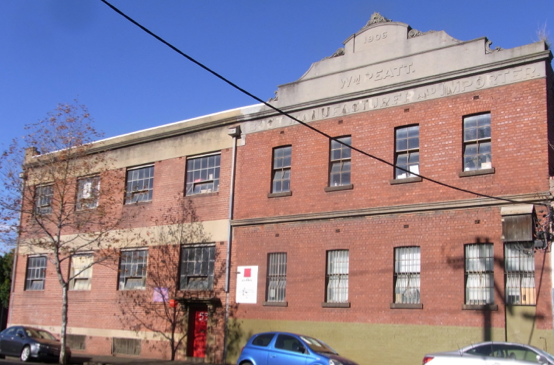Collingwood Notables Database
William Peatt
1819-1899
Bootmaker
In the 1870s William Peatt started a Collingwood boot making business which would be run by three generations of William Peatts and was still operating in the 1950s. The Peatt buildings remain standing in Langridge and Wellington streets.
In 1895 the Mercury and Weekly Courier published one of its fulsome articles on Local Industries. One wonders whether the industrialists paid for these. On the other hand, it is well to remember that working conditions in many factories were very poor indeed, so the mention of staff facilities in Peatt’s new building is worthy of note.
In the sixties, he made a start in a small way … in the nineties … at the head of a large establishment. … an immense building, now almost completed, at the intersection of Glasgow and Wellington street … 110 ft x 33 ft … machinery [includes] thirty machines worked by gas, the power being supplied by a seven horse power engine … accommodation for employees (there are 140) … is of the best possible character, due attention having been paid to ventilation and sanitation. There are lavatories for men and women, and in accordance with a provision in the Factories Act a fireplace for the purpose of warmth and … to boil water for tea-making. Large and commodious stables at the rear, and a cellar for preserving leather … the walls are fourteen inches [thick] … there are seventy-two boiler slate ventilators …. Circular-headed windows are to be seen in the Wellington-street side, and the attention paid to details to make the place attractive, reflect the greatest credit upon those who have taken part in the erection. Mr William Davies (a Collingwood resident of thirty-eight years’ standing), has been employed as clerk of works … Mr William Peatt jun, is the right-hand supporter of his father ... Next door to the factory is the newly erected residence of Mr Peatt. It is a handsome, commodious and well-finished place, containing seven rooms and a bathroom … both the factory and house do much to improve the appearance of the parade end of Wellington-street.
Mercury 7 March 1895 page 3
Peatt’s description of beginning his business in the 1860s is slightly disingenuous. English-born, he had worked in Ireland as a bootmaker before arriving in 1857 in NSW, where his widowed mother was already living. He established a boot and shoe business in Sydney, then sold it in the late 1860s and moved to Carlton. He worked as a publican at several hotels in Melbourne, but in 1872 he was declared insolvent, blamed on falling-off in business and bad debts at his Richmond hotel. Giving up hotel-keeping as a bad job, he returned to his trade, operating from the mid 1870s in a small factory behind his residence at 2 Northumberland Street Collingwood.
By the time the big new factory was built, Peatt was well into his seventies but seems to have continued to play an active part in the business. He was a patron of the Collingwood Football Club in 1898. He had fathered ten children, all of whom survived, and outlived three wives. (In a court case in which he was questioned about the age of one of his daughters, he replied crossly that a man with ten children could hardly be expected to remember where and when they were all born).
After Peatt senior’s death in 1899, his son William added another section to the factory. This was connected to the rear of the 1895 building and ran the full width of the block from Glasgow Street to Langridge Street. It was built in 1906, according to the date and name on the façade which faces Langridge Street, and would have doubled the size of the factory premises. A later addition to this wing was added on the east side between 1939 and 1945.
William junior also married three times, in 1868, 1878, and 1910. He lived in Northumberland Street in the 1870s and 1880s and at the time of his death in 1922 he and his third wife Helena were still living in the house next door to the Wellington Street factory. Rather bizarrely, in 1928 Helena proceeded against the company for noise and vibration affecting her house. William senior had lived in a variety of houses in Collingwood and Abbotsford although he returned to Northumberland Street in the later years of his life. William junior’s son William Arthur, born 1869, also worked in the business; he and his wife Clara lived at 57 Turner Street Abbotsford, but the era of factory proprietors living near their business was ending and by 1909 they had moved to Northcote. By 1923 the business had become a limited liability company.
In 1924 the training of young bootmakers was established at Collingwood Technical School, and became an apprenticeship trade in 1932, with heavy involvement from local boot making firms. Thomas Jackson, who was managing director of William Peatt Pty Ltd for some decades, was an active member of the technical school council. During World War 2, the company was a successful tenderer for the supply of 100,000 pairs of boots for the military. Accusations of price-fixing profiteering were made against ten companies by the Acting Minister for Supply, but rebutted by Peatt’s and other Collingwood boot makers Charles Trescowthick and Rampling and Hall.
Times changed dramatically for Australian manufacturing in the later twentieth century. Collingwood and Fitzroy were no longer the centre of the boot and shoe trade, but many of the old buildings remain as a reminder of the industrial past. The Lovell Chen citation of the Peatt factory reads in part:
... comparatively largely externally intact, and combines the typical arrangement of front office accommodation, as evidenced by the more formal presentation and entry to Wellington Street, with the factory spaces in the more utilitarian rear component of the building. The regular windows to the long north and south elevations … typical of windows provided to these buildings to facilitate even light to the interior working areas … of local aesthetic / architectural significance … red brick façade to Wellington Street is handsomely proportioned, and well detailed in the two flat-faced string courses at ground and first floor levels, separated by a moulded cornice; and the evenly-spaced windows at ground and first floors with overpainted round arches. The rendered stepped and corniced parapet with a female head moulding and flanking consoles is a prominent element.
64 Wellington Street
59 Langridge Street
Life Summary
| Birth Date | Birth Place |
|---|---|
| 1819 | Woolwich, Kent |
| Spouse Name | Date of Marriage | Children |
|---|---|---|
| Elizabeth Wallace, died 1852 | 1830s | Edward 1837, Mary Ann 1838-1941, William 1842-1922, Clementine 1847-1935. |
| Jane Peatt, died 16 June 1881 | c. 1853, Ireland | Isabella 1854, Eliza 1856, Thomas 1859 (Sydney), Margaret (Maggie) 1861, Victoria 1864, Susan 1866-1869. |
| Anne, 1853-April 1890 | 1884 |
| Home Street | Home City | Status of Building |
|---|---|---|
| 2 Northumberland Street | Collingwood | Demolished |
| 3 Cromwell Street | Collingwood | |
| Northampton Cottage, Islington Street | Collingwood | |
| 11 Nicholson Street | Abbotsford | |
| 66 Wellington Street | Collingwood | Demolished |
| Work Street | Work City | Status of Building |
|---|---|---|
| Northumberland Street | Collingwood | Demolished |
| 64 Wellington Street | Collingwood | Extant |
| 59 Langridge Street | Collingwood | Extant |
| Church | Lodge |
|---|---|
| Anglican |
| Death Date | Death Place | Cemetery |
|---|---|---|
| 22 October 1899 | Collingwood | MGC |
Sydney Morning Herald; The Argus; The Australasian; Leader; The Mercury; Weekly Times; Illustrated Australian News; The Age; The Sun (Sydney); Lovell Chen, City of Yarra Heritage Gaps Study; Cummings, Bitter roots, sweet fruit; Vines, Northern Suburbs Factory Study.



